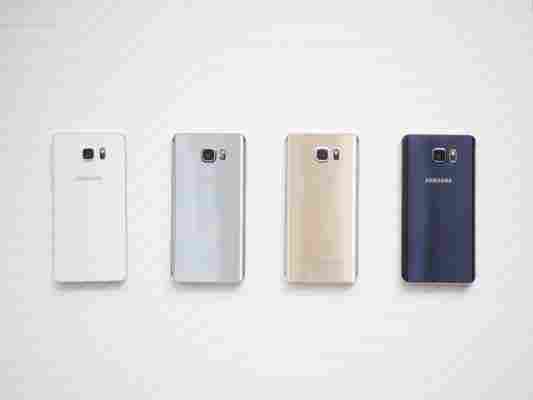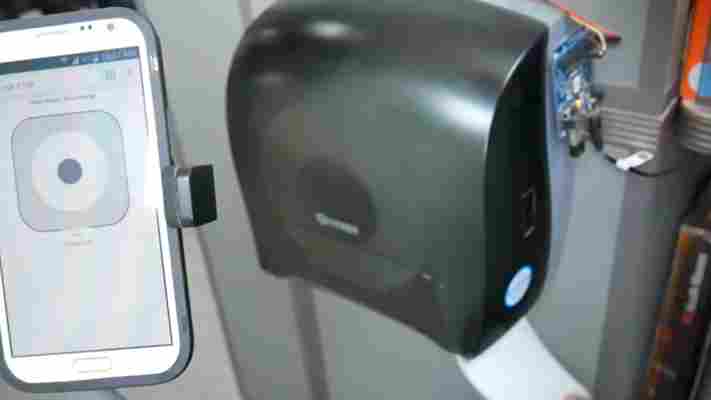Samsung today unveiled the Galaxy Note 5, the newest version of the device that first popularized the phablet form factor. Borrowing multiple cues and features from the Galaxy S6 and S6 Edge, the Note 5 is the most radical redesign of the series so far. We covered most of the device’s specs and features in our announcement post, but how does it fare in the real world?

If you’ve seen a Galaxy S6 or S6 Edge before, you know most of the design story on the Note 5. Like its smaller siblings, the Note line now features an all metal and glass construction, losing the removable pleather back in favor of a slimmer, shinier build.


That allows it to feel surprisingly compact for a device with a 5.7-inch screen (the same size as on the Note 4). The top and bottom bezels are kept to a minimum, and the side bezels are virtually non-existent. The glass back slopes inwards, making the device sit more comfortably in my smallish hands than I expected.
Unsurprisingly, it’s bit slippery – I almost dropped it the first time I picked it up. You might want a case, which will basically counteract any thinness advantages. The glass back is also a huge fingerprint magnet.
Nevertheless, it’s a beautiful phone, and has a display to match. The AMOLED display seems slightly more accurate than the panel on the Note 4, comparing them side by side. It’s still a bit oversaturated for my tastes, but Samsung wisely lets you customize the color reproduction in the display settings.
The S-Pen this time around is a little bit longer, with a heftier metal construction. It also now clicks in and out of place instead of just sliding out. You can also click the top like an old school dumb pen, which I found very satisfying, even if it doesn’t actually do anything.
Because there’s no removable back this time around, you lose the replaceable battery and microSD slot. The sleeker design likely necessitated some compromises, but it would’ve been nice to see Samsung keep the expandability on its larger phone line; Motorola’s latest Moto X still has a microSD slot, and the device is approximately the same size.
It’s fast. That’s no surprise given it features the same Exynos processor seen in the S6 devices, but I could not get it to slow down in the time I used it. I switched between apps without lag, browsing the Web was smooth, and the camera app open instantly by double-tapping on the home button.
Time will tell how it behaves once it’s loaded with a bunch of apps, but there’s no reason to expect it to perform worse than the S6.
My favorite new feature is the ability to seamlessly write notes with the S Pen. Once you pull the stylus out of its socket, the phone will let you write using white ‘ink’ on the screen – all without ever having to unlock the device or press a button. It’s almost like using an actual notepad, and since most of the screen isn’t lit up, it should help save some battery too.
The camera is the same module seen in the S6, and in my short time trialing it, it seemed just as good as ever. That is to say fast, with good saturated colors and ample details. Samsung says it’s also improved the stabilization in video mode, but I didn’t have the time to try this out.
I’m a bit torn. On one hand the Note 5’s design is miles ahead of its predecessor aesthetically; it’s beautiful and feels surprisingly great in the hand, despite the slipperiness.
On the other hand, I’m saddened Samsung has dropped any semblance of expandability, more than I was for the S6. The S6 is Samsung’s mainstream device, while the Notes – popular as they may also be – cater to a more niche audience.
It would’ve been nice to see Samsung keep the removable battery and expandable memory on the Note series to cement it as a sort of ‘pro’ line. As it stands, the Note Edge is little more than a larger S6 with a pen.
Not that that’s a bad thing – but it could also be more. Heck, Motorola managed to fit a microSD slot on a device practically the same size.
Still, it doesn’t seem like much of a stretch to say that this will be one of the most powerful and well-designed devices out there when it launches. That’s particularly true given Samsung is wisely getting the leg-up on Apple by launching the devices before Apple’s own event in September.
If the 3,000 mAh battery can keep up with all that power under the hood Samsung may have another winner on its hands.
Pre-orders for the Note 5 are already live; while there isn’t a set MSRP and carrier pricing may vary, AT&T is selling the device for $740 unlocked, so you can expect other carriers to price their devices similarly. The device will arrive in stores on August 21.
Read next: Hands-on with the Galaxy S6 Edge+ | Hands-on with the Samsung Galaxy snap-on keyboard
This smart toilet paper monitor tells you when you need a new roll
The future of consumer toilet accessories has never looked brighter.

YouTuber Sollae Insider has built a high-tech toilet paper solution that will essentially remind you anytime you need a new roll. Developed to help office caretakers easily keep track of bathrooms in need of a fresh roll, the quirky device monitors in real-time how much paper you got left in the holder.
Take a peek at the smart paper monitor in action in the video below:
To build the gadget, the resourceful inventor used a PHPoC Blue programmable IoT board as well as an HC-SR04 ultrasonic sensor, which he attached to the toilet paper holder. The monitor then measures the distance from the sensor to the surface of the paper roll to calculate if you need a new roll.
What’s particularly nifty is that the device can also connect to the internet, which means you can track your toilet paper needs online. While Sollae Insider designed the tool for office spaces and large buildings, you can easily implement the solution in your own home.
In case you want to put together your own smart toilet paper monitor, you can find detailed step-by-step instructions on this page . It takes about two days to build one – not a bad deal for something that could save you from a lifetime of shame.
New job posting at Google points to the revival of Glass
It looks like Google Glass may be making a comeback sometime soon.

Business Insider reports that a brand new Google job listing indicates not only the company’s continued efforts on behalf of the internet connected glasses, but that it may even be approaching production.
The hint? The Glass team is seeking an Advanced Technology Manufacturing Engineer, FATP (final assembly, test and pack) with responsibility for engineering in process development and mechanical fixture designs, expertise in design for manufacturability (DFM) and the ability to work with the ‘Quality and Reliability team’ for shipping.
Additional qualifications include experience in launching consumer products and a strong manufacturing background in scaling new products.
Google halted sales of Glass in January with vague references to a “strategy reset” under Nest chief Tony Fadell.
Since then, there have been scattered reports that a new version of Google Glass in conjunction with Luxottica , owners of Ray-Ban and other eyewear brands. Luxottica was quoted in the Wall Street Journal as saying that Glass 2.0 is “in preparation” and suggested that Google is pondering a more “radical change” for version 3.0.
That fits in with a previous BI report that the Glass team is extending its mission into “smart eyewear and other related products.”
